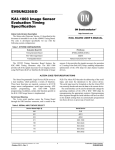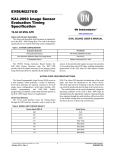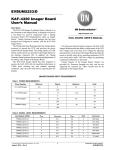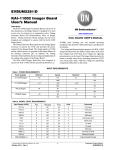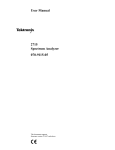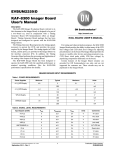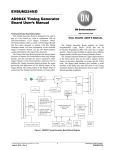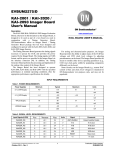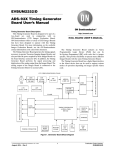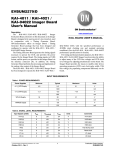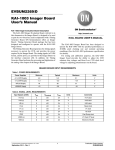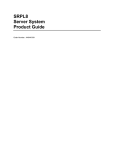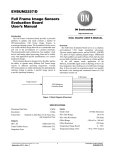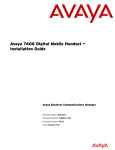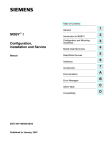Download EVBUM2265 - AD9945 Timing Generator Board User`s Manual
Transcript
EVBUM2265/D AD9945 Timing Generator Board User's Manual Timing Generator Board Description This Timing Generator Board is designed to be used as part of a two-board set, used in conjunction with a ON Semiconductor CCD Imager Evaluation Board. ON Semiconductor offers a variety of CCD Imager Boards that have been designed to operate with this Timing Generator Board. For more information on the available Imager Evaluation Boards, see the ON Semiconductor contact information at the end of this document. The Timing Generator Board generates the timing signals necessary to operate ON Semiconductor Imager Boards, and also provides the power required by these Imager Boards via the board interface connector (J6). In addition the Timing Generator Board performs the signal processing and digitization of the analog output of the Imager Board. Up to two analog outputs of the Imager Board are connected to the Timing Generator Board via coaxial cables. The KSC−1000 Timing Generator chip provides multiple pixel-rate, line-rate, and frame rate clocks and control signals to operate ON Semiconductor CCD image sensors. The KSC−1000 is able to operate many different Interline, Full-Frame, and Linear CCD image sensors. EVAL BOARD USER’S MANUAL The Timing Generator Board contains an Altera Programmable Logic Device (PLD) that can be In-System-Programmed (ISP) with code that is imager specific. This provides flexibility to operate many different Imager Boards with the same Timing Generator Board. The Timing Generator Board has a digital Input interface to the Altera device that can be used to support various modes of operation depending on imager-specific Altera code. The digital input interface also includes a serial interface to the KSC−1000 and AFE parts on the Timing Generator Board so that adjustments may be made to their operation, overriding the pre-programmed default operating conditions. JTAG Connector Configuration Switches SW[3..0] DIO[15..0] EPROM 3.3V Analog Regulator 3.3V Digital Regulator 1.8V Analog Regulator PLD_OUT[19..0] INTEGRATE KSC−1000 Timing Generator VD, HD, PIXEL_CLK SERIAL TG SLOAD TG6 SDATA, SCLK LVDS Drivers Hx, Vx, SHPx, SHDx, PBLK, INTG_START, LINE_VALID, FRAME_VALID, AMP_EN LVDS Drivers 100−pin SCSI Output Connector Altera PLD Board Interface Connector SERIAL INPUT Power Connector +5V, −5V, +20V, −20V System Clock Oscillator POWER_ON_DELAY Digital Input Buffers DIO Input Connector Board Reset Switch http://onsemi.com LINE_VALID, FRAME_VALID, DATACLK CHANNEL 1 OUT[11..0] CHANNEL 2 OUT[11..0] SLOAD AFE1 Analog Front End Line Receiver Op−Amp SDATA, SCLK, SHPx, SHDx, CLPOBx, PBLK Analog Front End Channel 1 Video In Line Receiver Op−Amp Integrate Channel 2 Video In SLOAD AFE2 Figure 1. 3F5592 Timing Generator Board Block Diagram © Semiconductor Components Industries, LLC, 2014 October, 2014 − Rev. 2 1 Publication Order Number: EVBUM2265/D EVBUM2265/D TIMING GENERATOR BOARD INPUT REQUIREMENTS The input power may be supplied by standard linear benchtop power supplies as long as they meet the requirements of a particular Evaluation Boardset. General guidelines for these requirements are shown in Table 1; refer to the appropriate Timing Specification for the input power requirements of a particular Evaluation Boardset. Table 1. POWER SUPPLY INPUT REQUIREMENTS Power Supplies Minimum Typical Maximum Unit +5V_MTR Supply 4.9 5 5.1 V 800 −5V_MTR Supply −5.1 VPLUS Supply 18 −5 mA −4.9 V 50 mA 20 21 V (Imager Board Dependent) VMINUS Supply −18 −20 mA −21 V (Imager Board Dependent) mA TIMING GENERATOR BOARD ARCHITECTURE OVERVIEW Power-On Delay/Board Reset The following sections describe the functional blocks of the Timing Generator Board (See Figure 1 for a block diagram). The POWER_ON_DELAY signal provides a reset signal to the Altera Programmable Logic Device (PLD) on power-up, or when the BOARD RESET button (S1) is pressed. The delay is generated by an RC network into a Schmitt trigger, and is approximately 400 ms, allowing power supply voltages to stabilize on the board. When the POWER_ON_DELAY signal goes high, the PLD will perform its normal power-up initialization sequence, as detailed in the applicable Timing Specification. Power Connector The J7 power connector provides the necessary power supply inputs to the Timing Generator Board. The connector also provides the VPLUS and VMINUS power supplies. These supplies are not used by the Timing Generator Board but are needed by the CCD Imager Boards. The Timing Generator Board simply routes these power supplies from the power connector to the board interface connector. System Clock The System Clock is used to generate the pixel rate clocks. The pixel rate timing signals operate at a frequency that is divided down from the System Clock frequency. The exact pixel rate frequency is Altera code dependent, but is limited to 1/2 the frequency of the System clock. Power Supply Filtering Power supplied to the board is de-coupled and filtered with ferrite beads and capacitors in order to suppress noise. For best noise performance, linear power supplies should be used to provide power to the boards. Table 2. TIMING BOARD CLOCK RATES Timing Board PN System Clock Pixel Clock (Max) 3F5592 40 MHz 20 MHz Digital Input Connector Any TTL-compatible digital controls may be used to control these lines. While it is recommended that these inputs range between +3.3 V (HIGH) and 0 V (LOW), voltages up to +5.0 V are acceptable. The digital input control lines to the board are buffered. The input pins to the buffer IC’s are weakly held low by pull down resistors to GND. Therefore, with no digital inputs, the default level of the control lines is all zeros. The digital input connector (J3) connects optional remote digital control signals to the evaluation board. These control signals, DIO[15..0], can be used to adjust the operating mode of the evaluation board. The function of the digital inputs depends on the Altera firmware programmed for a particular Evaluation Boardset, and is detailed in the associated Altera Code Timing Specification. This is an optional feature; no external digital inputs are required for board operation. http://onsemi.com 2 EVBUM2265/D Image Sensor LVDS Drivers A three-wire serial interface is also provided on the J3 input connector. The Altera PLD is programmed to decode the serial datastream, and steers the datastream to the KSC−1000 and the AFE chips as necessary. Therefore the KSC−1000 and each of the two AFE chips may be adjusted independently of one another via the serial interface, overriding the default settings stored in the Altera PLD. This is an optional feature, and is not required for board operation. Timing signals are sent to the Imager Board via the board interface connector (J5) using Low Voltage Differential Signaling (LVDS) drivers. LVDS combines high-speed connectivity with low noise and low power. Board Interface Connector This 80-pin connector (J5) provides both the timing signals and the necessary power to the CCD Imager Boards from the Timing Generator Board. Configuration Switches Altera PLD There are four switches on the board that can be used to adjust the operating mode of the Timing Generator Board. The function of the switches depends on how the Altera device is programmed for a particular Evaluation Boardset, and is detailed in the associated Altera Code Timing Specification. The Programmable Logic Device (PLD) is an Altera Flex 10K series part. Paired with an EPC2 configuration EPROM, the Altera device is In System Programmable (ISP) via a 10-pin JTAG header (J4) located on the board. In this way, the Altera device is programmed with imager-specific code to operate the Imager Board to which the Timing Generator Board will be connected. The code implemented in the Altera PLD is specific to each CCD Imager Board configuration, and is detailed in the associated Timing Specification document. At a minimum, the Altera PLD must provide these functions: • Decode and steer serial input data to the correct device; • Program the KSC−1000 with default settings; • Program the AFE chips with default settings. JTAG Header This 10-pin header (J4) provides the user with the ability to reprogram the Altera PLD in place via Altera’s BYTEBLASTER programming hardware. Purchasers of a ON Semiconductor Evaluation Board Kit may, at their discretion, make changes to the Altera code firmware. ON Semiconductor Inc. can only support firmware developed and supplied by ON Semiconductor Inc. Changes to the Altera code firmware are at the risk of the customer. When programming the Altera PLD via the JTAG interface, the Imager Board must be disconnected from the Timing Board, by removing the Board Interface Cable before power is applied. If the Imager Board is connected to the Timing Board during the reprogramming of the Altera PLD, damage to the Imager Board may occur. In addition to these functions, the Altera PLD may provide auxiliary timing and control functions for a particular CCD Imager Board. Refer to the appropriate Timing Specification for details. Serial Input Steering When the three-wire serial input to the Timing Board is used, the Altera PLD decodes the addressing of the serial input, and steers the datastream to the correct device. The serial input must be formatted so that the Altera PLD can correctly decode and steer the data to the correct device. The first 3 bits in the datastream are the Device Select bits DS[2..0], sent MSB first, as shown in Figure 2. The Device Select bits are decoded as shown in Table 3. Integrate Output Connector This output header (J6) provides a signal that is high during the integration time period. INTEGRATE can be used to synchronize an external shutter or LED light source with the integration time period. Table 3. SERIAL INPUT DEVICE SELECT Device Select DS[2..0] Serial Device 000 PLD 001 AFE1 010 AFE2 011 KSC−1000 100 (Imager Board Dependent) 101 (Imager Board Dependent) 110 (Imager Board Dependent) 111 (Imager Board Dependent) http://onsemi.com 3 EVBUM2265/D SLOAD SDATA … Dn Address bits A[2..0], LSB first, followed by a Test bit which is always set LOW. The remaining bits in the bitstream are Data bits, LSB first, with as many bits as are required to fill the appropriate register. DS2 DS1 DS0 R/W A0 A1 A2 A3 (or Test) D0 D1 D2 D3 D4 The next bit in the datastream is the Read/Write bit (R/W). Only writing is supported; therefore this bit is always LOW. The definition of next four bits in the datastream depends on the device being addressed with the Device Select bits. For the KSC−1000 device, they are Register Address bits A[3..0], LSB first. For the AD9945 AFE, they are Register ÏÏÏÏÏÏÏÏÏÏÏÏÏÏ ÏÏÏÏÏÏÏÏÏÏÏÏÏÏ SCLK Figure 2. Serial Input Timing three-wire serial interface. The default settings are specific to each CCD Imager Board configuration, and are detailed in the associated Timing Specification document. The Altera PLD receives the serial datastream, decodes the Device Select address contained in the first 3 bits, and sets the appropriate SLOAD line LOW. The remaining datastream is then read in real time by the selected device. The Altera PLD does not do any checking of the datastream for correctness; it merely steers the data to the appropriate device. AFE Default Programming Upon power-up, or whenever the BOARD_RESET button is pressed, the Altera PLD programs the registers of the two AFE chips on the AFE Timing Generator Board to their default settings via the three-wire serial interface. The default settings are specific to each CCD Imager Board configuration, and are detailed in the associated Timing Specification document. KSC−1000 Default Programming Upon power-up, or whenever the BOARD_RESET button is pressed, the Altera PLD automatically programs the registers of the KSC−1000 to their default settings via the Table 4. TIMING BOARD CONFIGURATION OPTIONS Timing Board PN Analog Devices PN Sampling Rate Bit Depth Channels 3F5592 AD9945KCP 20 MSPS 12 2 Video Signal Processing Auxiliary PLD functions The Altera PLD may provide auxiliary timing and control functions for a particular CCD Imager Board. In addition to the Configuration switches, Remote Digital Inputs, and 3-wire Serial Interface, the inputs to the PLD include timing signals from the KSC−1000. The PLD outputs include: PLD[2..0], auxiliary outputs which are routed to the Board Interface connector (J5); HD_TG and VD_TG, timing controls signals to the KSC−1000; and ARSTZ, an asynchronous reset to the KSC−1000. These inputs and outputs allow the Altera PLD to monitor the CCD timing, and to control auxiliary functions as needed. There are several PLD connections that are connected only to test points. These may be configured as PLD outputs or inputs, for extra monitoring or control. Each of the two signal processing channels is designed to process an analog video signal input from a CCD Imager Board. The analog video signal is buffered by an operational amplifier. This amplifier is in a non-inverting configuration with a gain of 1.25. The output of the amplifier is then AC-coupled into the input of the AFE chip. Since the amplitude of AFE input is limited, care must be taken to adjust the gain of the Imager Board signal prior to the AFE input. The Imager Board for a particular CCD image sensor has been designed to deliver a video signal with the correct amplitude to the Timing Board, such that, when the AFE is correctly configured, optimum performance is achieved. http://onsemi.com 4 EVBUM2265/D AD9945 Analog Front End (AFE) Device The Timing Generator Board has two analog input channels, each consisting of an operational amplifier buffer and an Analog Front End (AFE) device. The AFE chip processes the video signal, then performs the A/D conversion and outputs 12 bits of digital information per pixel. The Timing Generator Board supports the AD9945 AFE device offered by Analog Devices Inc. Refer to the Analog Devices AD9945 Specification Sheet (Reference 2) for details on the operation of this Analog Front End. Table 5. AFE REGISTERS Register Address Register Description Notes 0 Operation 1 1 Control 1 2 Clamp Level 1 3 VGA Gain 1 1. See the AD9945 specifications sheet (Reference 2) for details. frame-grabber hardware. The output connector interfaces directly to the National Instruments PCI−1424 frame-grabber, providing two channels of 12 bit output data in parallel in LVDS differential format. The connector also provides the three necessary PCI−1424 frame grabber synchronization signals in LVDS differential format. The AFE registers can be adjusted by re-programming the registers using the three-wire serial interface provided on the Digital Input Connector. Each AFE is independently addressable through the Altera PLD, and therefore can be adjusted independently. Digital Image Data LVDS Drivers Digitized image data and synchronization timing signals are sent to the computer frame-grabber hardware via the 100-pin SCSI output connector (J9) using Low Voltage Differential Signaling (LVDS) drivers. LVDS combines high-speed connectivity with low noise and low power. KSC−1000 Timing Generator The KSC−1000 controls the overall flow of the evaluation board operation. The TG outputs include the CCD clocks signals, AFE timing signals, and Frame Grabber synchronization signals. The KSC−1000 is configured by programming Registers, Frame Tables, and Line Tables. SCSI Digital Output Connector This 100-pin connector (J9) provides digitized image data and synchronization timing signals to the computer Table 6. KSC−1000 REGISTERS Register Address Register Description Notes 0 Frame Table Pointer 1 1 General Setup 1 2 General Control 1 3 INTG_STRT Setup 1 4 INTG_STRT Line 1 5 Signal Polarity 1 6 Offset 1 7 Width 1 8 Frame Table Access 1 9 Line Table Access 1 10 Status 1 1. See the KSC−1000 specification sheet (Reference 3) for details. http://onsemi.com 5 EVBUM2265/D CONNECTOR ASSIGNMENTS AND PINOUTS SMB Connectors J1 and J2 J1 (Channel 1) and J2 (Channel 2) allow connection of analog video signal(s) from the CCD Imager Boards through correctly terminated 75 W coaxial cable. Digital Input Connector J3 Table 7. DIGITAL INPUT CONNECTOR J3 Pin Assignment Function Pin Assignment 1 SLOAD SERIAL PORT 2 GND 3 SDATA SERIAL PORT 4 GND 5 SCLOCK SERIAL PORT 6 GND 7 DIO15 Altera Code Dependent 8 GND 9 DIO14 Altera Code Dependent 10 GND 11 DIO13 Altera Code Dependent 12 GND 13 DIO12 Altera Code Dependent 14 GND 15 DIO11 Altera Code Dependent 16 GND 17 DIO10 Altera Code Dependent 18 GND 19 DIO9 Altera Code Dependent 20 GND 21 DIO8 Altera Code Dependent 22 GND 23 DIO7 Altera Code Dependent 24 GND 25 DIO6 Altera Code Dependent 26 GND 27 DIO5 Altera Code Dependent 28 GND 29 DIO4 Altera Code Dependent 30 GND 31 DIO3 Altera Code Dependent 32 GND 33 DIO2 Altera Code Dependent 34 GND 35 DIO1 Altera Code Dependent 36 GND 37 DIO0 Altera Code Dependent 38 GND 39 NC (Not Used) 40 GND JTAG Connector J4 Table 8. JTAG CONNECTOR Pin Assignment 1 TCK 2 AGND 3 TDO 4 +3.3 V 5 TMS 6 AGND 7 AGND 8 AGND 9 TDI 10 AGND http://onsemi.com 6 EVBUM2265/D Board Interface Connector J5 Table 9. BOARD INTERFACE CONNECTOR J5 Pin Assignment Pin Assignment 1 TIMING_OUT0+ 2 TIMING_OUT0− 3 AGND 4 AGND 5 TIMING_OUT1+ 6 TIMING_OUT1− 7 AGND 8 AGND 9 TIMING_OUT2+ 10 TIMING_OUT2− 11 AGND 12 AGND 13 TIMING_OUT3+ 14 TIMING_OUT3− 15 AGND 16 AGND 17 TIMING_OUT4+ 18 TIMING_OUT4− 19 AGND 20 AGND 21 TIMING_OUT5+ 22 TIMING_OUT5− 23 AGND 24 AGND 25 TIMING_OUT6+ 26 TIMING_OUT6− 27 AGND 28 AGND 29 TIMING_OUT7+ 30 TIMING_OUT7− 31 AGND 32 AGND 33 TIMING_OUT8+ 34 TIMING_OUT8− 35 AGND 36 AGND 37 TIMING_OUT9+ 38 TIMING_OUT9− 39 AGND 40 AGND 41 TIMING_OUT10+ 42 TIMING_OUT10− 43 AGND 44 AGND 45 TIMING_OUT11+ 46 TIMING_OUT11− 47 N.C. 48 N.C. 49 AGND 50 AGND 51 TIMING_OUT12+ 52 TIMING_OUT12− 53 −20 V_IMG 54 −20 V_IMG 55 TIMING_OUT13+ 56 TIMING_OUT13− 57 AGND 58 AGND 59 TIMING_OUT14+ 60 TIMING_OUT14− 61 −5 V_MTR 62 −5 V_MTR 63 TIMING_OUT15+ 64 TIMING_OUT15− 65 AGND 66 AGND 67 TIMING_OUT16+ 68 TIMING_OUT16− 69 +5 V_MTR 70 +5 V_MTR 71 TIMING_OUT17+ 72 TIMING_OUT17− 73 AGND 74 AGND 75 TIMING_OUT18+ 76 TIMING_OUT18− 77 +20 V_IMG 78 +20 V_IMG 79 TIMING_OUT19+ 80 TIMING_OUT19− http://onsemi.com 7 EVBUM2265/D Integrate Sync Connector J6 Table 10. INTEGRATE SYNC CONNECTOR J6 Pin Assignment Function 1 INTEGRATE Signal is High during Integration Time Period 2 AGND Power Connector J7 Table 11. POWER CONNECTOR J7 Pin Assignment 1 VMINUS 2 AGND 3 VPLUS 4 AGND 5 −5 V_MTR 6 AGND 7 +5 V_MTR 8 AGND Configuration Switches S2 Table 12. CONFIGURATION SWITCHES S2 Switch Assignment Function S2−1 SW1 Altera Code Dependent S2−2 SW2 Altera Code Dependent S2−3 SW3 Altera Code Dependent S2−4 SW4 Altera Code Dependent Output Connector J9 Table 13. OUTPUT CONNECTOR J9 Pin Assignment Signal Level Pin Assignment Signal Level 1 AOUT0+ LVDS 2 AOUT0− LVDS 3 AOUT1+ LVDS 4 AOUT1− LVDS 5 AOUT2+ LVDS 6 AOUT2− LVDS 7 AOUT3+ LVDS 8 AOUT3− LVDS 9 AOUT4+ LVDS 10 AOUT4− LVDS 11 AOUT5+ LVDS 12 AOUT5− LVDS 13 AOUT6+ LVDS 14 AOUT6− LVDS 15 AOUT7+ LVDS 16 AOUT7− LVDS 17 AOUT8+ LVDS 18 AOUT8− LVDS 19 AOUT9+ LVDS 20 AOUT9− LVDS 21 AOUT10+ LVDS 22 AOUT10− LVDS 23 AOUT11+ LVDS 24 AOUT11− LVDS 25 N.C. 26 N.C. http://onsemi.com 8 EVBUM2265/D Table 13. OUTPUT CONNECTOR J9 (continued) Pin Assignment 27 Signal Level Pin Assignment Signal Level N.C. 28 N.C. 29 N.C. 30 N.C. 31 N.C. 32 N.C. 33 N.C. 34 N.C. 35 N.C. 36 N.C. 37 N.C. 38 N.C. 39 N.C. 40 N.C. 41 FRAME+ LVDS 42 FRAME− LVDS 43 LINE+ LVDS 44 LINE− LVDS 45 N.C. 46 N.C. 47 N.C. 48 N.C. 49 PIXEL+ LVDS 50 PIXEL− LVDS 51 BOUT0+ LVDS 52 BOUT0− LVDS 53 BOUT1+ LVDS 54 BOUT1− LVDS 55 BOUT2+ LVDS 56 BOUT2− LVDS 57 BOUT3+ LVDS 58 BOUT3− LVDS 59 BOUT4+ LVDS 60 BOUT4− LVDS 61 BOUT5+ LVDS 62 BOUT5− LVDS 63 BOUT6+ LVDS 64 BOUT6− LVDS 65 BOUT7+ LVDS 66 BOUT7− LVDS 67 BOUT8+ LVDS 68 BOUT8− LVDS 69 BOUT9+ LVDS 70 BOUT9− LVDS 71 BOUT10+ LVDS 72 BOUT10− LVDS 73 BOUT11+ LVDS 74 BOUT11− LVDS 75 N.C. 76 N.C. 77 N.C. 78 N.C. 79 N.C. 80 N.C. 81 N.C. 82 N.C. 83 N.C. 84 N.C. 85 N.C. 86 N.C. 87 N.C. 88 N.C. 89 N.C. 90 N.C. 91 N.C. 92 N.C. 93 N.C. 94 N.C. 95 N.C. 96 N.C. 97 N.C. 98 N.C. 99 AGND 100 AGND http://onsemi.com 9 EVBUM2265/D WARNINGS AND ADVISORIES Board during the reprogramming of the Altera PLD, damage to the Imager Board will occur. Purchasers of a ON Semiconductor Evaluation Board Kit may, at their discretion, make changes to the Timing Generator Board firmware. ON Semiconductor can only support firmware developed by, and supplied by, ON Semiconductor. Changes to the firmware are at the risk of the customer. ON Semiconductor is not responsible for customer damage to the Timing Board or Imager Board electronics. The customer assumes responsibility and care must be taken when probing, modifying, or integrating the ON Semiconductor Evaluation Board Kits. When programming the Timing Board, the Imager Board must be disconnected from the Timing Board before power is applied. If the Imager Board is connected to the Timing ORDERING INFORMATION ON Semiconductor reserves the right to change any information contained herein without notice. All information furnished by ON Semiconductor is believed to be accurate. Please address all inquiries and purchase orders to: Truesense Imaging, Inc. 1964 Lake Avenue Rochester, New York 14615 Phone: (585) 784−5500 E-mail: [email protected] ON Semiconductor and the are registered trademarks of Semiconductor Components Industries, LLC (SCILLC) or its subsidiaries in the United States and/or other countries. SCILLC owns the rights to a number of patents, trademarks, copyrights, trade secrets, and other intellectual property. A listing of SCILLC’s product/patent coverage may be accessed at www.onsemi.com/site/pdf/Patent−Marking.pdf. SCILLC reserves the right to make changes without further notice to any products herein. SCILLC makes no warranty, representation or guarantee regarding the suitability of its products for any particular purpose, nor does SCILLC assume any liability arising out of the application or use of any product or circuit, and specifically disclaims any and all liability, including without limitation special, consequential or incidental damages. “Typical” parameters which may be provided in SCILLC data sheets and/or specifications can and do vary in different applications and actual performance may vary over time. All operating parameters, including “Typicals” must be validated for each customer application by customer’s technical experts. SCILLC does not convey any license under its patent rights nor the rights of others. SCILLC products are not designed, intended, or authorized for use as components in systems intended for surgical implant into the body, or other applications intended to support or sustain life, or for any other application in which the failure of the SCILLC product could create a situation where personal injury or death may occur. Should Buyer purchase or use SCILLC products for any such unintended or unauthorized application, Buyer shall indemnify and hold SCILLC and its officers, employees, subsidiaries, affiliates, and distributors harmless against all claims, costs, damages, and expenses, and reasonable attorney fees arising out of, directly or indirectly, any claim of personal injury or death associated with such unintended or unauthorized use, even if such claim alleges that SCILLC was negligent regarding the design or manufacture of the part. SCILLC is an Equal Opportunity/Affirmative Action Employer. This literature is subject to all applicable copyright laws and is not for resale in any manner. PUBLICATION ORDERING INFORMATION LITERATURE FULFILLMENT: Literature Distribution Center for ON Semiconductor P.O. Box 5163, Denver, Colorado 80217 USA Phone: 303−675−2175 or 800−344−3860 Toll Free USA/Canada Fax: 303−675−2176 or 800−344−3867 Toll Free USA/Canada Email: [email protected] N. American Technical Support: 800−282−9855 Toll Free USA/Canada Europe, Middle East and Africa Technical Support: Phone: 421 33 790 2910 Japan Customer Focus Center Phone: 81−3−5817−1050 http://onsemi.com 10 ON Semiconductor Website: www.onsemi.com Order Literature: http://www.onsemi.com/orderlit For additional information, please contact your local Sales Representative EVBUM2265/D










